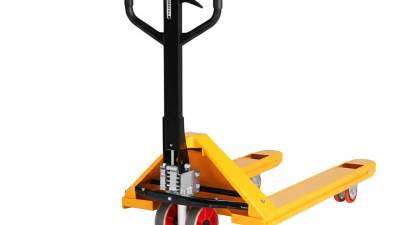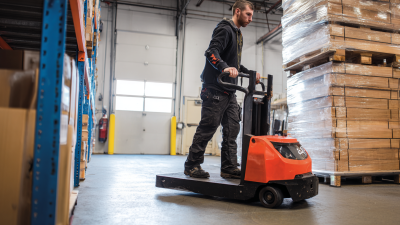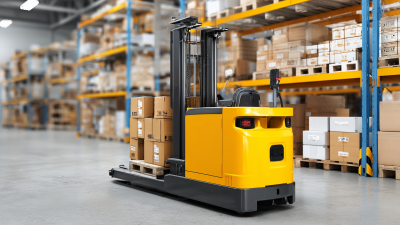Leave Your Message
In today's fast-paced warehouse operations, the efficient movement of goods is paramount, and one of the essential tools for achieving this is the Manual Pallet Jack. This versatile piece of equipment allows workers to transport pallets of varying weights and sizes with ease, improving productivity while minimizing the risk of injury.

However, to maximize the benefits of using a Manual Pallet Jack, it’s crucial to understand the best practices and safety measures associated with its operation. By following a set of effective strategies, warehouse personnel can ensure not only their own safety but also the smooth functioning of warehouse logistics.
This guide will delve into the top tips and methods for using a Manual Pallet Jack safely and efficiently, empowering staff to handle materials more effectively and contribute to a streamlined operational workflow.
Manual pallet jacks play a pivotal role in enhancing warehouse efficiency. According to a report by the Material Handling Industry of America, implementing efficient material handling systems can increase warehouse operations' productivity by up to 30%. Manual pallet jacks, with their ability to transport goods easily over short distances, are essential tools in reducing labor times and mitigating the risks of material damage due to improper handling. With the average warehouse employing around 100 workers, the efficiency derived from effective manual pallet jack usage can significantly impact overall operational output.
In addition to improving speed and efficiency, manual pallet jacks also promote workplace safety. The Occupational Safety and Health Administration (OSHA) highlights that improper lifting and transporting techniques can lead to serious injuries, accounting for approximately 20% of workplace injuries in the warehousing sector. By leveraging manual pallet jacks, workers can minimize the physical strain associated with lifting heavy loads, thereby fostering a safer work environment. Integrating these tools into daily operations not only streamlines processes but also reinforces a culture of safety within warehouses, ultimately benefiting both employees and the organization's bottom line.
Operating a manual pallet jack in high-traffic areas requires strict adherence to safety protocols to prevent accidents and ensure efficiency. One of the key protocols is to maintain clear visibility while maneuvering. Always ensure that your path is free of obstacles, and use signals or communicate with nearby coworkers when you are moving through congested areas. This proactive approach reduces the likelihood of collisions and creates a safer work environment for everyone.
Tips: When working in crowded spaces, try to approach loads slowly and deliberately. This not only helps in maintaining better control but also allows you to react quickly to unexpected changes in traffic. Additionally, ensure that the manual pallet jack is properly maintained; check the wheels and brakes regularly to ensure they are in working condition.
Another crucial safety aspect is to be aware of your surroundings. Stay alert for pedestrians and other equipment that may be operating nearby. It’s essential to establish a safe distance between yourself and others when transporting loads. By keeping an eye out for potential hazards, you can navigate through high-traffic areas more effectively.
Tips: Use a speed that allows you to stop or change direction quickly if necessary. If you’re transporting heavy loads, always keep the load low to the ground to maintain stability and avoid tipping hazards.
When operating a manual pallet jack, understanding the impact of load capacity on performance and safety compliance is crucial. Manual pallet jacks are designed with specific load limits, and exceeding these can lead to inefficient movement, increased wear on the equipment, and compromised safety. For instance, a fully loaded pallet jack that surpasses its capacity can become difficult to maneuver, increasing the risk of accidents or injuries during operation.
Tips: Always verify the load capacity marked on the pallet jack before use. It’s advisable to weigh the load when possible, ensuring it remains within safe limits. Regular inspections of the pallet jack's condition, including wheels and forks, are also essential for maintaining optimal performance.
Moreover, operators should be trained to recognize the signs of overload, such as difficulty in steering or lifting. By adhering to proper guidelines, workers can enhance both efficiency and safety. Understanding and respecting the maximum load capacity not only optimizes workflow but also plays a vital role in creating a safe working environment.
When operating a manual pallet jack, comprehensive training is essential for ensuring safety and efficiency in warehouse operations. Operators should receive thorough instruction on the components of the pallet jack, including its steering mechanism, lifting function, and safety features. Additionally, understanding the weight capacity and proper loading techniques is crucial to prevent accidents and equipment damage. Training should also cover the ergonomic principles of pushing and pulling to minimize the risk of injury.
Best practices for manual pallet jack operation include conducting regular inspections to identify any wear and tear that could affect safety. Operators should be taught to maintain clear pathways and ensure that the area is free of obstacles before moving loads. It is also important to emphasize the significance of communicating with coworkers when maneuvering heavy loads in tight spaces. Encouraging a culture of safety, where operators feel comfortable reporting issues, can further enhance the efficiency of warehouse operations and contribute to a safer working environment.
Proper maintenance and inspection of manual pallet jacks are essential to ensure longevity and safe operation within warehouse environments. Before each use, operators should conduct a thorough inspection, checking for any visible damage to the fork, wheels, and hydraulic system. Specifically, they should look for cracks, leaks, and unusual wear that might indicate a need for repair or replacement. Additionally, operators should ensure that the wheels are clean and free from debris to guarantee smooth maneuverability.
Routine maintenance involves regularly lubricating moving parts, such as the wheels and pivot points, to prevent wear and maintain efficiency. It's also crucial to keep the hydraulic system functioning properly; this includes checking the fluid levels and looking for signs of leaks. A proactive maintenance schedule can significantly reduce the likelihood of equipment failure, thereby improving both safety and productivity in your warehouse operations. By adhering to these inspection and maintenance guidelines, warehouse managers can enhance the reliability of their manual pallet jacks and create a safer working environment for all employees.
| Inspection Criteria | Frequency of Inspection | Maintenance Tasks | Recommended Actions |
|---|---|---|---|
| Wheel Condition | Daily | Lubricate wheels | Replace worn wheels |
| Forks | Weekly | Check for cracks and bend | Repair or replace damaged forks |
| Hydraulic System | Monthly | Check oil levels | Inspect for leaks |
| Handle | Weekly | Inspect for secure attachment | Tighten loose handles |
| Brake Function | Daily | Test brake functionality | Adjust or repair brakes |






